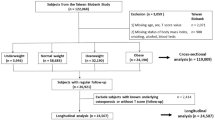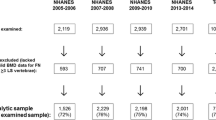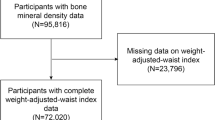Abstract
Introduction
Overweight is increasing worldwide, but particularly in the United States of America. Higher body weight is associated with higher bone density, so our goal was to estimate whether the higher prevalence of overweight is likely to reduce osteoporosis among older women.
Methods
We calculated the prevalence of osteoporosis by weight status in older women using data from the third National Health and Nutrition Examination Survey (NHANES III, 1988–94). We defined overweight as a body mass index (BMI) ≥25 and osteoporosis as a femur neck bone mineral density (BMD) value 2.5 standard deviations or more below the mean of that of young women. To estimate the expected prevalence of osteoporosis, we applied the prevalence of osteoporosis by weight status from NHANES III to the corresponding weight status prevalence from NHANES 1999–2002.
Results
Of older women in NHANES 1999–2002, 68% were overweight compared to 62% in NHANES III. Overweight status was significantly related to osteoporosis prevalence (P < 0.001). However, the expected prevalence of osteoporosis in NHANES 1999–2002 was only slightly lower than that seen in NHANES III (16.8% vs 18.1%, respectively).
Conclusions
The increasing prevalence of overweight among older US women appears unlikely to be accompanied by a significant reduction in osteoporosis.

Similar content being viewed by others
References
National Osteoporosis Foundation (2002) America’s bone health: the state of osteoporosis and low bone mass in our nation. National Osteoporosis Foundation, Washington, DC
Looker AC, Orwoll ES, Johnston CC Jr, et al (1997) Prevalence of low femoral bone density in older adults from NHANES III. J Bone Miner Res 12:1761–1768
Hedley AA, Ogden CL, Johnson CL, et al (2004) Prevalence of overweight and obesity among US children, adolescents and adults 1999–2002. JAMA 291:2847–2850
Flegal KM, Carroll MD, Kuczmarski RJ, Johnson CL (1998) Overweight and obesity in the United States: prevalence and trends, 1960–1994. Int J Obes 22:39–47
Edelstein SL, Barrett-Connor E (1993) Relation between body size and bone mineral density in elderly men and women. Am J Epidemiol 138:160–169
Felson DT, Zhang Y, Hannan MT, Anderson JJ (1993) Effects of weight and body mass index on bone mineral density in men and women: the Framingham Study. J Bone Miner Res 8:567–573
Bauer DC, Browner WS, Cauley JA, et al (1993) Factors associated with appendicular bone mass in older women. The Study of Osteoporotic Fractures Research Group. Ann Intern Med 118:657–665
Glauber HS, Vollmer WM, Nevitt MC, et al (1995) Body weight versus body fat distribution, adiposity, and frame size as predictors of bone density. J Clin Endocrinol Metab 80:1118–1123
Holbrook TL, Barrett-Connor E (1993) The association of lifetime weight and weight control patterns with bone mineral density in an adult community. Bone Miner 20:141–149
Plan and Operation of the Third National Health and Nutrition Examination Survey (1994) 1988–94: series 1: programs and collection procedures. Vital Health Stat 1 32:1–407
National Center for Health Statistics NCHS definitions: Race. Available at http://www.cdc.gov/nchs/datawh/nchsdefs/race.htm. Accessed 2 September 2005
Wahner H, Looker A, Dunn W, et al (1994) Quality control of bone densitometry in a national health survey (NHANES III) using three mobile examination centers. J Bone Miner Res 9:951–960
World Health Organization (1994) Assessment of fracture risk and its application to screening for postmenopausal osteoporosis. Technical Report Series No. 843. WHO, Geneva Switzerland
Shah BV, Barnwell BG, Hunt PN, et al (1991) SUDAAN User’s Manual, Release 5.50. Research Triangle Institute, Research Triangle Park, NC
Niewenweg R, Smit ML, Walenkamp JE, et al (2003) Adult height corrected for shrinking and secular trend. Ann Hum Biol 30:563–569
Schenker N, Gentleman JF (2001) On judging the significance of differences by examining overlap between confidence intervals. Am Statistician 55:182–186
Dargent-Molina P, Poitiers F, Breart G for the EPIDOS group (2000) In elderly women weight is the best predictor of a very low bone mineral density: evidence from the EPIDOS Study. Osteoporos Int 11:881–888
Barrera G, Bunout D, Gattas V, et al (2004) A high body mass index protects against femoral neck osteoporosis in healthy elderly subjects. Nutrition 20:769–771
Albala C, Yanez M, Devoto E, et al (1996) Obesity as a protective factor for postmenopausal osteoporosis. Int J Obes 20:1027–1032
Kleerekoper M, Nelson DA, Peterson EL, et al (1994) Body composition and gonadal steroids in older white and black women. J Clin Endocrinol Metab 79:775–779
Khosla S, Atkinson EJ, Riggs BL, et al (1996). Relationship between body composition and bone mass in women. J Bone Miner Res 11:857–863
Gallagher D, Visser M, Sepulveda D, et al (1996) How useful is body mass index for comparison of body fatness across age, sex, and ethnic groups? Am J Epidemiol 143:228–239
Reid IR (2002) Relationships among body mass, its components, and bone. Bone 31:547–555
Twomey LT, Taylor JR (1987) Age changes in lumbar vertebrae and intervertebral discs. Clin Orthop Relat Res 224:97–104
Rockhill B, Newman B, Weinberg C (1998) Use and misuse of population attributable fractions. Am J Public Health 88:15–19
De Laet C, Kanis J, Oden A, et al (2005) Body mass index as a predictor of fracture risk: a meta-analysis. Osteoporos Int 16:1330–1338
National Center for Health Statistics. Health, United States (2004) With chartbook on trends in the health of Americans. Hyattsville MD: National Center for Health Statistics; 2004. Available at:http://www.cdc.gov/nchs/data/hus/hus04.pdf. Accessed 22 June 2005
Bialostosky K, Wright JD, Kennedy-Stephenson J, et al (2002) Dietary intake of macronutrients, micronutrients, and other dietary constituents: United States 1988–94. series 11: data from the National Health and Nutrition Examination Survey. Vital Health Stat 11 245:1–155
Ervin RB, Wang CY, Wright JD, et al (2004) Dietary intake of selected minerals for the United States population: 1999–2000. Advance Data from Vital and Health Statistics 341:1–8
Stafford RS, Drieling RL, Hersh AL (2004) National trends in osteoporosis visits and osteoporosis treatment, 1988–2003. Arch Intern Med 164:1525–1530
Jaglal S, Weller I, Mamdani M, et al (2005) Population trends in BMD testing, treatment and hip and wrist fracture rates: are the hip fracture projections wrong? J Bone Miner Res 20:898–905
Newman ED, Ayoub WT, Starkey RH, et al (2003) Osteoporosis disease management in a rural health care population: hip fracture reduction and reduced costs in postmenopausal women after 5 years. Osteoporos Int 14:146–151
Melton LJ 3rd, Kanis JA, Johnell O (2005). Potential impact of osteoporosis treatment on hip fracture trends. J Bone Miner Res 20:895–897
Elliot-Gibson V, Bogoch ER, Jamal SA, et al (2004) Practice patterns in the diagnosis and treatment of osteoporosis after a fragility fracture: a systematic review. Osteoporos Int 15:767–778
Tosteson ANA, Grove MR, Hammond CS, et al (2003) Early discontinuation of treatment for osteoporosis. Am J Med 115:209–216
McCombs JS, Thiebaud P, McLaughlin-Miley C, et al (2005) Compliance with drug therapies for the treatment and prevention of osteoporosis. Maturitas 48:271–287
Acknowledgments
The findings and conclusions in this report are those of the authors and do not necessarily represent the views of the Centers for Disease Control and Prevention.
Author information
Authors and Affiliations
Corresponding author
Rights and permissions
About this article
Cite this article
Looker, A.C., Flegal, K.M. & Melton, L.J. Impact of increased overweight on the projected prevalence of osteoporosis in older women. Osteoporos Int 18, 307–313 (2007). https://doi.org/10.1007/s00198-006-0241-8
Received:
Accepted:
Published:
Issue Date:
DOI: https://doi.org/10.1007/s00198-006-0241-8




